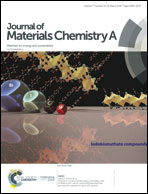Polymeric iodobismuthates {[Bi3I10]} and {[BiI4]} with N-heterocyclic cations: promising perovskite-like photoactive materials for electronic devices†
Abstract
A screening of the reactions between BiI3 and iodide salts of different N-alkylated heterocycles (pyridine, quinoline, isoquinoline) resulted in the preparation and structural characterization of six novel iodobismuthate complexes, including two compounds exhibiting an unprecedented {[Bi3I10]} polymeric moiety. It has been shown that the chemical composition and structure of the iodobismuthates significantly affect their optical and electronic properties. In particular, the narrowest band gaps (Eg) were revealed by {[Bi3I10]} iodobismuthates, while the compounds incorporating {[BiI4]} polymeric frameworks showed 0.2–0.3 eV wider Eg. GIXRD analysis evidenced that all three iodobismuthates investigated in thin films show mainly the horizontal (parallel to the substrate) orientation of the 1D polymeric Bi–I frameworks. Such arrangement blocks the charge transport in vertical direction (orthogonal to the substrate) since the conductive Bi–I chains are separated with insulating bulky organic cations. As a consequence, standard planar junction solar cells based on new iodobismuthates revealed low power conversion efficiencies approaching 0.12% only. However, strong in-plane photoconductivity observed for iodobismuthates enabled the fabrication of efficient planar photodetectors, which paves a way to the practical use of this exotic family of materials. Most importantly, the presented systematic study revealed the most general guidelines for future rational design of perovskite-like materials for emerging generation of environment-friendly perovskite photovoltaics emphasizing the importance of the isotropic charge transport in the films of 3D materials and achieving proper orientation of 1D and 2D frameworks with respect to the charge collecting electrodes in anisotropic low dimensional systems.
![Graphical abstract: Polymeric iodobismuthates {[Bi3I10]} and {[BiI4]} with N-heterocyclic cations: promising perovskite-like photoactive materials for electronic devices](/en/Image/Get?imageInfo.ImageType=GA&imageInfo.ImageIdentifier.ManuscriptID=C8TA09204D&imageInfo.ImageIdentifier.Year=2019)


 Please wait while we load your content...
Please wait while we load your content...